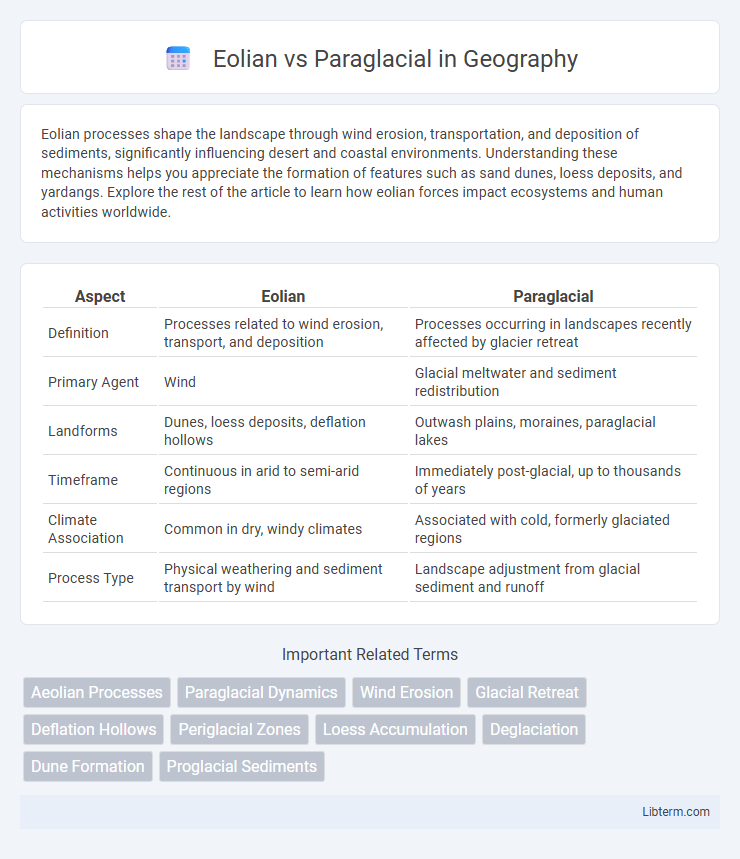Eolian processes shape the landscape through wind erosion, transportation, and deposition of sediments, significantly influencing desert and coastal environments. Understanding these mechanisms helps you appreciate the formation of features such as sand dunes, loess deposits, and yardangs. Explore the rest of the article to learn how eolian forces impact ecosystems and human activities worldwide.
Table of Comparison
| Aspect | Eolian | Paraglacial |
|---|---|---|
| Definition | Processes related to wind erosion, transport, and deposition | Processes occurring in landscapes recently affected by glacier retreat |
| Primary Agent | Wind | Glacial meltwater and sediment redistribution |
| Landforms | Dunes, loess deposits, deflation hollows | Outwash plains, moraines, paraglacial lakes |
| Timeframe | Continuous in arid to semi-arid regions | Immediately post-glacial, up to thousands of years |
| Climate Association | Common in dry, windy climates | Associated with cold, formerly glaciated regions |
| Process Type | Physical weathering and sediment transport by wind | Landscape adjustment from glacial sediment and runoff |
Introduction to Eolian and Paraglacial Processes
Eolian processes involve the transportation and deposition of sediments by wind, shaping landscapes through phenomena such as dune formation and deflation. Paraglacial processes refer to the sediment redistribution and landscape adjustments that occur in response to glacier retreat, involving mass wasting, fluvial reworking, and slope stabilization. Both processes play critical roles in geomorphology, influencing sediment dynamics and post-glacial environmental evolution.
Defining Eolian Features and Formations
Eolian features are landforms shaped primarily by wind action, including dunes, loess deposits, and yardangs, formed from the erosion, transportation, and deposition of sediment in arid and semi-arid environments. Paraglacial refers to landscapes influenced by glacial retreat and meltwater processes, distinct from eolian dynamics. Understanding eolian formations involves examining wind patterns, sediment availability, and sediment transport mechanics that create characteristic landforms like barchan dunes and sand seas.
Understanding Paraglacial Environments
Paraglacial environments describe landscapes undergoing adjustment following glacial retreat, characterized by sediment instability and dynamic geomorphic processes reshaping terrain. In contrast, eolian processes involve wind-driven sediment transport and deposition, often dominant in arid or semi-arid regions. Understanding paraglacial zones is critical for predicting sediment fluxes, landscape evolution, and ecosystem development in post-glacial terrains.
Key Differences Between Eolian and Paraglacial Systems
Eolian systems are shaped primarily by wind-driven processes, resulting in features such as dunes and loess deposits, while paraglacial systems are influenced by the transitional conditions following glacial retreat, characterized by rapid sediment redistribution and unstable landforms. Eolian environments exhibit aeolian transport mechanisms like saltation and suspension, contrasting with paraglacial dynamics that involve meltwater erosion, permafrost thaw, and thermokarst development. The temporal scale also differs as eolian processes operate continuously in arid regions, whereas paraglacial conditions are transient phases linked to deglaciation periods.
Geological Impacts of Eolian Activity
Eolian activity, driven by wind processes, significantly shapes geological landscapes by transporting and depositing sediments, creating features such as dunes, loess plains, and deflation hollows. These wind-driven deposits influence soil formation, alter hydrological patterns, and impact ecosystem development over geological time scales. In contrast, paraglacial processes primarily reshape landscapes through the release of glacial sediments following ice retreat, but lack the continuous sediment redistribution power characteristic of eolian dynamics.
Paraglacial Influence on Landscape Evolution
Paraglacial processes significantly influence landscape evolution by accelerating sediment redistribution and altering landform stability following glacial retreat. These processes intensify erosion, mass wasting, and fluvial dynamics, reshaping valleys, river terraces, and moraines. Understanding paraglacial impacts is crucial for predicting sediment flux and geomorphic responses in post-glacial environments.
Climate Factors Affecting Eolian and Paraglacial Processes
Eolian processes are primarily driven by wind strength, aridity, and temperature fluctuations that influence sediment transport and deposition in dry, open landscapes. Paraglacial processes respond to post-glacial climatic conditions such as thawing permafrost, increased precipitation, and meltwater flow, which reshape landscapes through slope instability and sediment redistribution. Climate factors like seasonal temperature variations and shifts in moisture availability play critical roles in modulating both eolian deflation and paraglacial sediment fluxes.
Case Studies: Eolian vs. Paraglacial Landforms
Eolian landforms, such as dunes and loess deposits, form through wind-driven processes and are prominently studied in arid environments like the Nebraska Sand Hills, where sediment sorting and dune migration patterns are well documented. Paraglacial landforms, including outwash plains and moraines, result from glacial meltwater dynamics and have been extensively analyzed in regions like the European Alps, illustrating sediment reworking post-glaciation. Comparative case studies reveal distinct sediment transport mechanisms and morphological features, highlighting the influence of climatic conditions on landscape evolution in both eolian and paraglacial contexts.
Human Impacts on Eolian and Paraglacial Dynamics
Human activities such as agriculture, deforestation, and urbanization significantly alter eolian dynamics by increasing soil exposure and accelerating wind erosion, leading to degraded land surfaces and dust storms. In paraglacial environments, infrastructure development, mining, and increased sediment extraction disrupt natural sediment supply and destabilize glacial landforms, exacerbating erosion and altering post-glacial landscape evolution. These anthropogenic impacts intensify natural processes, creating feedback loops that accelerate landscape changes and threaten ecosystem stability in both eolian and paraglacial systems.
Future Research Directions in Eolian and Paraglacial Studies
Future research in eolian and paraglacial studies should prioritize integrating high-resolution remote sensing technologies and advanced geospatial modeling to better understand sediment dynamics under changing climatic conditions. Emphasis on interdisciplinary approaches combining geomorphology, climatology, and ecology will enhance predictive capabilities for landscape evolution in arid and glacially influenced regions. Developing standardized frameworks for monitoring and quantifying sediment transport will facilitate comparative studies and improve assessments of environmental impacts related to desertification and glacial retreat.
Eolian Infographic

 libterm.com
libterm.com